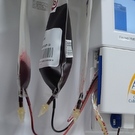Study Finds Donor Lymphocyte Infusions Are More Effective When Used Preemptively In Myeloma Transplant Patients

Results of a recent retrospective analysis suggest that donor lymphocyte infusions appear to work better when they are used in patients who have residual multiple myeloma than in those who have relapsed after a donor stem cell transplant.
Donor lymphocyte infusions are considered a preemptive treatment when used in transplant patients with residual disease, and a salvage treatment when used in transplant patients who have relapsed.
“The relapse rate is high with allogeneic (donor) stem cell transplants. Donor lymphocyte infusions can improve outcomes if utilized for residual disease,” said Dr. Amer Beitinjaneh, the study’s lead investigator from the MD Anderson Cancer Center in Houston.
Dr. Beitinjaneh and his colleagues suggested that the role of donor lymphocyte infusions after mini donor transplants should be investigated further in prospective clinical trials.
Donor, or allogeneic, stem cell transplants have the potential to cure myeloma. In this procedure, stem cells are collected from a healthy donor and infused into a myeloma patient after high-dose chemotherapy. Despite its curative potential for multiple myeloma, there is still a high risk of relapse after a donor stem cell transplant. Additionally, donor transplantation is a risky procedure due to the potential for life-threatening complications.
Donor lymphocyte infusion, often abbreviated "DLI," is a procedure in which white blood cells are collected from a patient’s stem cell donor and infused into the patient sometime after transplantation. These donor cells have the ability to recognize and attack cancer cells, thereby lowering the risk of relapse.
Donor lymphocyte infusions are performed in myeloma, lymphoma, and leukemia patients whose disease persists after receiving a donor stem cell transplant.
Previous research has shown that donor lymphocyte infusions may be an effective therapy for patients who relapse after a donor stem cell transplant. In addition, the infusions have shown efficacy as a preemptive treatment for patients who have not relapsed after transplantation, but have signs of residual disease.
In the current study, researchers from the MD Anderson Cancer Center in Houston retrospectively analyzed data from 23 multiple myeloma patients who had received a donor stem cell transplant followed by one or more donor lymphocyte infusions at their institution between 1996 and 2008.
All patients had received a mini, or nonmyeloablative, donor transplant in which they were given a low dosage of chemotherapy and radiation prior to transplantation.
Of the 23 patients included in the analysis, 52 percent received the donor transplant as part of their initial therapy, 35 percent received it as salvage therapy for relapsed disease after transplantation with their own cells, and 13 percent received it as part of a double transplant after transplantation with their own cells.
Following their donor transplants, 48 percent of patients achieved at least a very good partial response. However, 65 percent of patients eventually relapsed within a median of nine months.
The 65 percent of patients who relapsed received received donor lymphocyte infusions in an attempt to address the relapse. The other 35 percent of the patients in the MD Anderson sample received donor lymphocyte infusions because they had signs of residual disease.
Thirty percent of patients in the sample received more than one donor lymphocyte infusion.
The median time between the transplant and the first donor lymphocyte infusion was 8.4 months.
After a median follow-up time of 24 months, 21 percent of the patients in the sample achieved at least a very good partial response, and 34 percent had stable disease, following their donor lymphocyte infusions.
The researchers noted that the best responses were generally observed after the first infusion. The median duration of response was 21.8 months for patients achieving at least a very good partial response.
Patients with residual disease who received a donor lymphocyte infusion were more likely to achieve at least a very good partial response compared to patients who received an infusion due to relapse (50 percent versus 7 percent).
Additionally, the patients treated for residual disease demonstrated longer median progression-free survival (11.9 months versus 5.2 months) and median overall survival (28.3 months versus 7.6 months).
Dr. Beitinjaneh explained that patients with residual disease had a lower tumor burden than those who had relapsed. In addition, none of the patient with residual disease when they received their infusions had bone or soft-tissue disease.
No patients in the sample died as a result of their donor lymphocyte infusions. However, 26 percent of the patients experienced acute graft-versus-host disease (GVHD), a potentially serious complication, in which the donor’s stem cells attack healthy cells in the recipient’s body within 100 days after a donor transplant or infusion.
Another 6 percent of the patients had chronic GVHD, which occurs 100 days after a transplant or infusion.
According to Dr. Beitinjaneh, the rate of GVHD after donor lymphocyte infusions was not significantly higher than observed after transplantation, which he attributes to the timing of the infusion and the lower starting dose of the infusions.
The researchers found that the period between the transplant and donor lymphocyte infusion was shorter in patients who developed acute GVHD after their transplant compared to those who did not (6.9 months versus 15 months).
For more information, please see the study in Leukemia & Lymphoma (abstract).
Related Articles:
- None Found


Thanks for all the information you provide and for remembering the very small group of us that have done Allogeneic transplants. I believe Immunotherapy is the wave of the future, so I am excited to see MD Anderson doing research on DLI's.
I also just wanted to remind everyone that if they have a healthy relative or friend that could potentially serve as a Stem Cell Donor they should have that person contact the Be the Match Registry at http://marrow.org/Home.aspx
They can provide a fellow Blood Cancer Patient a chance at a cure for their disease. Everyone reading here knows what great hope that provides for a Cancer patient.